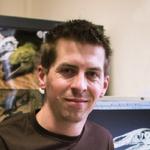| Short Biography |
My research focuses on biomechanical analysis and 3D visualisation in palaeontology. I combine traditional methods in palaeontology, such as comparative anatomy and morphological phylogeny, with modern techniques by employing state-of-the-art hard- and software technology, including CT scanning and computer generated modelling. By using a variety of techniques for data acquisition (e. g., CT and Synchrotron scanning, Photogrammetry, Laser Scanning), I am not only able to create accurate models of fossil specimens, but also to look inside these specimens. Such non-destructive sampling allows the identification, reconstruction and visualisation of soft tissue structures, for example the brain and inner ear of dinosaurs or the jaw closing musculature of Triassic reptiles.
I further use the digital models to assess biomechanical and functional properties of complex skeletal structures (often in combination with the reconstructed soft tissue structures). To do that, I apply methods such as Finite Element Analysis, a technique originally developed for engineering. However, in order to gain reliable and accurate results, the models of the fossils specimens have to be reconstructed first to remove preservational artefacts (breaks, cracks, deformation). To facilitate this, I use software tools, originally developed for 3D modelling and animation (Blender, Maya), but also custom-made software scripts. |
